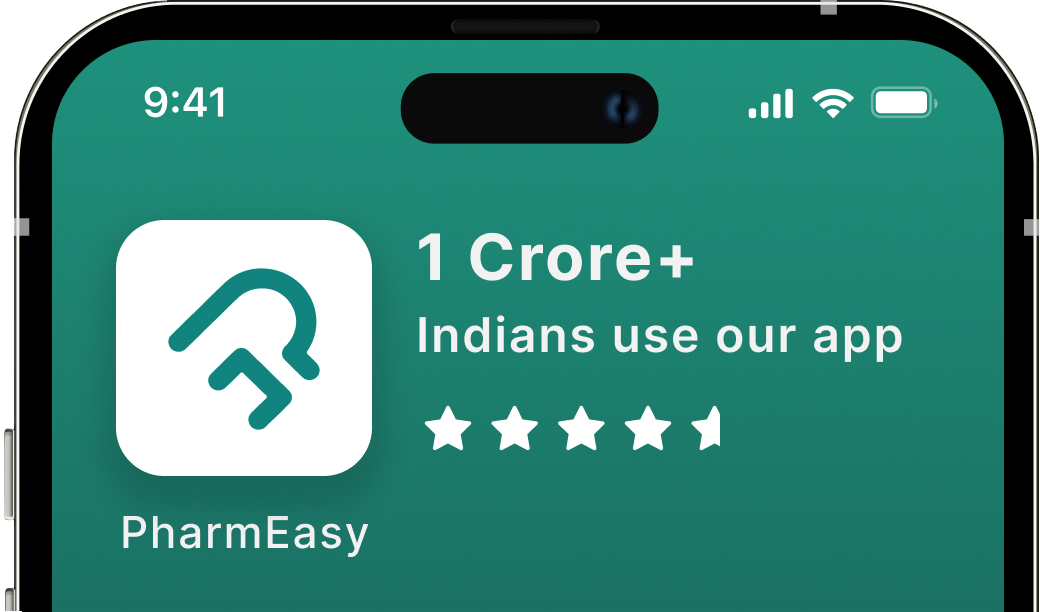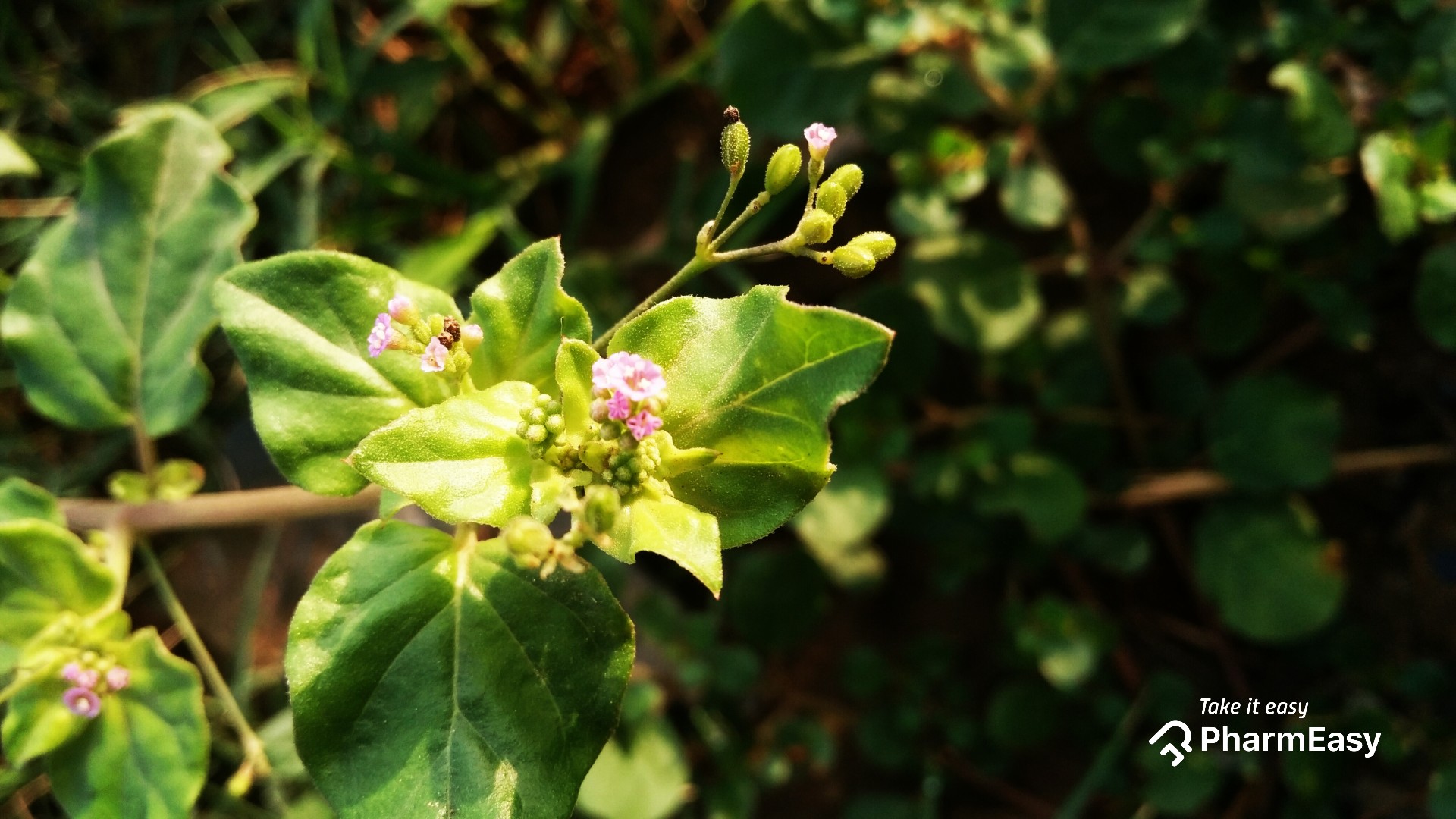Punarnava: Uses, Benefits, Side Effects & More
By Dr. Raghuveer +2 more

Get,

to manage your symptom
Get your,


4 Cr+ families
benefitted

OTP sent to 9988776655



You’ve successfully subscribed to receive
doctor-approved tips on
Whatsapp

Get ready to feel your best.

Hi There,
Download the PharmEasy App now!!


Register to Avail the Offer
Send OTPBy continuing, you agree with our Privacy Policy and Terms and Conditions

Hi There,
Sign up on PharmEasy now!!
Trusted by 4 crore+ families

OTP sent to 9988776655



You have unlocked 25% off on medicines




Code: NU25
By Dr. Raghuveer +2 more
Table of Contents
Punarnava is an indigenous plant with numerous medicinal properties. Punarnava derives its name from its nature of growth and proliferation. The aerial part of the plant dries up in the summer and regenerate in the rainy season; Its name, Punarnava, comes from the Sanskrit words ‘Punar’ meaning “again” and ‘Nava’ meaning “new,” symbolising the plant’s ability to renew and restore itself1.

Punarnava is called Hogweed in English, and the botanical name of the plant is Boerhavia diffusa2.
This plant has many different names in India, such as:
Based on my experience, I have observed that the ethyl acetate extract from the roots of punarnava may have strong antifungal properties. It has shown the ability to inhibit the growth of fungal species such as Microsporum gypseum, M. fulvum, and M. canis. The extract hinders the growth and reproduction of these fungi, suggesting its potential use as an effective antifungal8.
Dr. Siddharth Gupta, B.A.M.S, M.D (Ayu)
Punarnava has been in use in Ayurveda since ancient times. All parts of the plant are utilised in the preparation of various formulations, owing to their wide range of medicinal properties.
Punarnava may be beneficial in managing symptoms of rheumatism and gout.
In my experience, I have observed that Punarnava may possess notable spasmolytic properties, meaning it can help relax muscles by reducing their contractions. This effect is believed to be linked to its influence on calcium regulation within the muscles, as well as the presence of active compounds such as boeravinone E8.
Dr. Smita Barode, BAMS
Also Read: Arjunarishta: Uses, Benefits, Side Effects & More!
The Punarnava plant and its parts are traditionally used in different forms to prepare remedies for a range of health conditions, as outlined below:
Your Ayurvedic physician will determine the appropriate form and dosage based on your individual health condition.
Also Read: Peepal Tree: Uses, Benefits, Side Effects and More!
Although no side effects have been reported so far. It is important to note that these herbal remedies are generally prescribed as part of a treatment regimen, where one preparation may help to balance the effects of another. It is important to use such remedies only under the supervision of a qualified practitioner.
Over the years, based on my experience and observations, I believe that Punarnava may have notable anticonvulsant properties. Some studies8 have shown its potential in helping to reduce seizures. This effect is thought to be linked to a compound in the plant known as liriodendron, which may work by blocking calcium activity in the brain.
Dr. Rajeev Singh, BAMS
Also Read: Clove (Laung): Uses, Benefits, Side Effects and More!
Punarnava may interact with the following medications:
Also Read: Tamarind (Imli): Uses, Benefits, Side Effects and More!
Punarnava has been traditionally valued for its wide range of supportive health benefits. However, it should be used responsibly and under medical supervision. Always consult a qualified doctor before starting any herbal treatment.
Punarnava may help to effectively manage obesity by reducing appetite. It may also detoxify the body and prevent fluid retention, which may help in weight loss.
Glaucoma is a condition characterised by increased pressure within the eye, which can sometimes be associated with diabetes. Punarnava, known for its blood sugar-lowering properties, may help support overall glucose management. Traditionally, the root of Punarnava when ground on a stone and applied carefully to the eyes over several days, is believed to provide soothing relief for certain eye conditions.
The Punarnava plant may be helpful in kidney disorders like irregular blood pressure and diuresis. The plant extract is commonly used as a diuretic to help flush the kidneys. Both the powdered form and aqueous decoction of the extract are traditionally used to support the management of nephrotic syndrome.
The root of the plant is powdered and mixed with mamira (Thalictrum foliosum) to help soothe the symptoms of eye disorders like corneal ulcers and night blindness. The leaves of the plant may be used to make ophthalmic lotions for various eye disorders.
Yes, Punarnava may be beneficial to reduce fluid accumulation in the abdomen. It also helps to reduce the symptoms of ascites caused due to liver diseases.
Punarnava is known to be beneficial for the kidneys. It may help support the function of nephrons damaged by diabetes and act as an effective diuretic, promoting increased filtration. This process can assist in flushing out excess fluids and toxins from the body.
1. Bihari Dora B, Dora BB, Gupta S, Sital S, Pastore A. Punarnava (Boerhavia diffusa): A Promising Indigenous Herbal Drug and Its Effect on Different Disease Conditions. 2015 [cited 2022 Feb 15];21–4. Available from: https://sciencejournals.stmjournals.in/index.php/RRJoHS/article/view/715
2. Abbi C, Kumar V, Kumar S, Kumar D. Punarnava (Boerhavia diffusa): A promising indigenous herbal drug. Int Res J Pharm. 2013;4(3):85–89. Available from: https://www.researchgate.net/publication/269846433_PUNARNAVA_BOERHAVIA_DIFFUSA_A_PROMISING_INDIGENOUS_HERBAL_DRUG
3. Umamaheswari A, Nuni A, Shreevidya R. Evaluation of antibacterial activity of Boerhaavia diffusa L. leaves. Int J Green Pharm. 2010;4(2):88–92. Available from: https://www.researchgate.net/publication/44298779_Evaluation_of_antibacterial_activity_of_Boerhaavia_diffusa_L_leaves
4. Rao PP. Ophthalmic uses of Boerhaavia diffusa L. (Punarnava): Review. J Med Plants Stud. 2016;4(2):78–80.Available from: https://www.researchgate.net/publication/335381955_Ophthalmic_uses_of_Boerhaavia_Diffusa_L_Punarnava_Review
5. Rajendran K, Raj C D, Ramakrishnan V, Krishnan UM. Therapeutic efficacy of Punarnavadi mandura against phenylhydrazine-induced hemolytic anemia in rats. J Tradit Complement Med. 2025;15(1):93–104. Available from: https://www.sciencedirect.com/science/article/pii/S2225411024000361
6. Patil GG, Shettar RV. Evaluation of the efficacy of Punarnavadi Guggulu & Mahamashadi Taila Kati Basti in the management of Gridhrasi (Sciatica). J Ayurveda Integr Med Sci. 2019;4(2):15–23. Available from: https://jaims.in/jaims/article/view/588
7. Shah VN, Shah MB, Bhatt PA. Hepatoprotective activity of punarnavashtak kwath, an Ayurvedic formulation, against CCl₄-induced hepatotoxicity in rats and on the HepG2 cell line. Pharm Biol. 2011;49(4):408–15. doi:10.3109/13880209.2010.521162. PMID: 21391842. Available from: https://pubmed.ncbi.nlm.nih.gov/21391842/
8. Mishra S, Aeri V, Gaur PK, Jachak SM. Phytochemical, therapeutic, and ethnopharmacological overview for a traditionally important herb: Boerhavia diffusa Linn. Biomed Res Int. 2014;2014:808302. doi:10.1155/2014/808302. Epub 2014 May 14. PMID: 24949473; PMCID: PMC4053255. Available from: https://pmc.ncbi.nlm.nih.gov/articles/PMC4053255/
Disclaimer: The information provided here is for educational/awareness purposes only and is not intended to be a substitute for medical treatment by a healthcare professional and should not be relied upon to diagnose or treat any medical condition. The reader should consult a registered medical practitioner to determine the appropriateness of the information and before consuming any medication. PharmEasy does not provide any guarantee or warranty (express or implied) regarding the accuracy, adequacy, completeness, legality, reliability or usefulness of the information; and disclaims any liability arising thereof.
Comments

Leave your comment...
You may also like
Comments